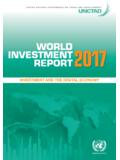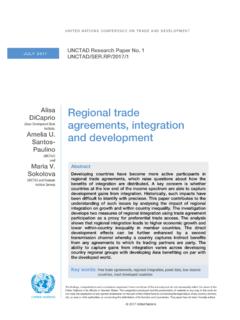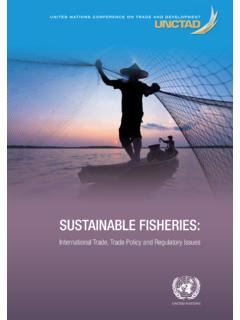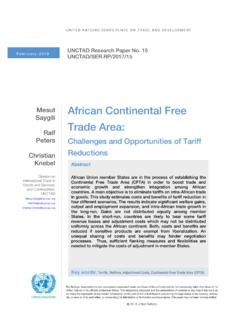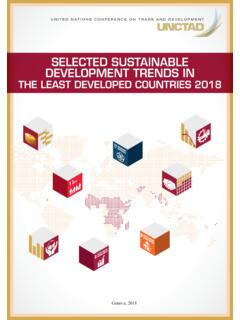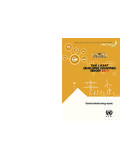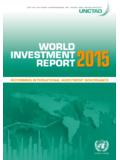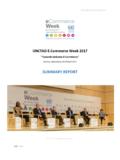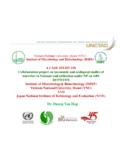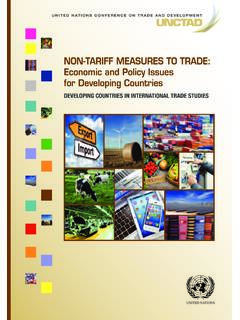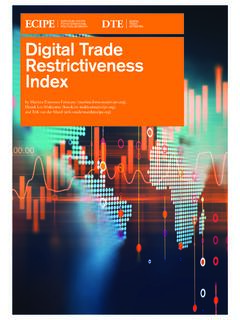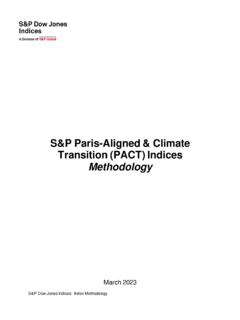Transcription of Key Statistics and Trends in Trade Policy 2021
1 Credit: Adobe Stock xyz+, tuastockphoto, OulailuxUNITED NATIONS CONFERENCE ON Trade AND DEVELOPMENT KEY Statistics AND TRENDSThe Regional Comprehensive Economic PartnershipTariff Concessions in Trade Policy 2021 KEY Statistics AND TRENDSThe Regional Comprehensive Economic PartnershipTariff Concessions in Trade Policy 2021 UNITED NATIONS CONFERENCE ON Trade AND DEVELOPMENTG eneva, 2022 Key Statistics and Trends in Trade Policy 2021iiUNCTAD Division on International Trade and Commodities 2022, United NationsThe work is available open access by complying with the Creative Commons licence created for intergovernmental organizations, available at findings, interpretations and conclusions expressed herein are those of the authors and do not necessarily reflect the views of the United Nations or its officials or Member designation employed and the presentation of material on any map in this work do not imply the expression of any opinion whatsoever on the part of the United Nations concerning the legal status of any country, territory, city or area or of its authorities, or concerning the delimitation of its frontiers or and reproductions of excerpts are allowed with proper publication has not been formally Nations publication issued by the United Nations Conference on Trade and 978-92-1-001360-4 Print ISSN 2409-7713 Online ISSN 2707-7160 UNCTAD/DITC/TAB/2022/2iiiUNCTAD Division on International Trade and CommoditiesCONTENTSNOTE.
2 IvOVERVIEW ..vDATA SOURCES ..viGLOSSARY ..viiIN FOCUS: THE REGIONAL COMPREHENSIVE ECONOMIC PARTNERSHIP TARIFF CONCESSIONS ..11. TARIFFS ..5 Average import and export restrictiveness , by region ..5 Multilateral and preferential tariff liberalization ..6 Free Trade and remaining tariffs, by broad category ..7 Trade weighted average tariffs, by region, broad category and sector ..8 Tariff peaks, by region, broad category and sector (2020) ..9 Tariff escalation by region, broad category and sector (2020) ..10 Tariff restrictiveness , matrix by region (percentage), 2020 ..11 Relative preferential margins, matrix by region (percentage), 2020 ..12 Import restrictiveness ..132. Trade AGREEMENTS ..14 Trade agreements ..14 Importance of preferential Trade agreements ..15 Policy space: Multilateral constraints.
3 163. NON-TARIFF MEASURES ..17 Prevalence of non-tariff measures, by type and broad category (2020) ..17 Non-tariff measures, by sector (2020) ..18 Technical non-tariff measures, by country ..19 Border measures: coverage and ad-valorem equivalents (2020) ..204. Trade DEFENCE MEASURES..21 Trade defence measures (2005 2020) ..21 Trade defence measures, by country ..22 Key Statistics and Trends in Trade Policy 2021ivUNCTAD Division on International Trade and CommoditiesNOTEKey Statistics and Trends in Trade Policy is a yearly publication of the Trade Analysis Branch, Division on International Trade and Commodities, UNCTAD secretariat. The main purpose of this publication is to inform on the use and effects of a wide range of Trade policies influencing international series is part of a larger effort by UNCTAD to analyse Trade -related issues of particular importance to developing countries in terms of their participation in the international trading system, as requested by the mandate of the fourteenth session of the United Nations Conference on Trade and Development.
4 This study was prepared by Alessandro Division on International Trade and CommoditiesOVERVIEWI nternational Trade is subject to and influenced by a wide array of policies and instruments. Technical measures and requirements regulate about two thirds of world Trade , while various forms of sanitary and phytosanitary measures (SPS) are applied to almost all agricultural products. Border measures contribute substantially to Trade costs. On average the compliance costs of such measures are generally higher than tariffs. The World Trade Organization (WTO) remains an important arbiter of Trade disputes, however the past few years have seen a general decrease in the number of Trade defence investigations brought to the WTO. As of 2020, there is a large number of Trade defence measure in force, most of them by developed countries and major emerging the notable exception of the increase in bilateral tariffs between the United States of America and China, tariffs have remained substantially stable during the last few years with tariff protection remaining a significant factor in some sectors and markets.
5 Tariffs have been marginally reduced in some of the sectors as to facilitate Trade of products related to the COVID-19 pandemic. As of 2020, Trade costs directly related to tariffs were at about 2 per cent for developed countries and at about 4 per cent for developing countries. Tariff restrictiveness remains substantial in many developing countries, especially in South Asian and African countries. Moreover, tariffs remain relatively high in some sectors where tariff peaks are present. Those sectors include some of key interest to low-income countries such as agriculture, apparel, textiles and leather products. Tariffs also remain substantial for most South South Trade . The process of deeper economic integration has remained strong at the regional and bilateral levels, with an increasing number of preferential Trade agreements (PTAs) being negotiated and implemented.
6 Most of the recent PTAs address not only goods but also services and increasingly deal with rules beyond reciprocal tariff concessions to cover a wide range of behind the border issues. As of 2020, about half of world Trade has occurred under some form of PTA. While the COVID-19 pandemic has severely disrupted international Trade , Trade under deep Trade agreements has been relatively more resilient, increasing the share of Trade under deep PTA further in 2020. This report is structured in two parts. The first part provides a discussion and Statistics on the tariff concessions of the Regional Comprehensive Economic Partnership. The second part presents and discusses Trends in selected Trade Policy instruments, including illustrative Statistics . The second part is divided into four chapters: tariffs, Trade agreements, non-tariff measures and Trade defence measures.
7 Trade Trends and Statistics are provided at various levels of aggregation illustrating the use of the Trade Policy measures across economic sectors and geographic regions. Key Statistics and Trends in Trade Policy 2021viUNCTAD Division on International Trade and CommoditiesDATA SOURCESAll Statistics in this publication have been produced by the UNCTAD secretariat by using data from various sources. Data on tariffs and non-tariff measures originate from the UNCTAD Trade Analysis and Information System (TRAINS) database ( ), while data on bound tariffs derive from the WTO s Consolidated Tariff Schedules database ( ). Trade data are from the United Nations Commodity Trade Statistics Database (COMTRADE; ). Data on Trade defence measures are sourced from the WTO I-TIP ( ).
8 Tariff and Trade data are at the Harmonized System 6-digit level and have been standardized to ensure comparability across countries. Data related to preferential Trade agreements are derived from various databases, including the WTO regional Trade agreement gateway ( ) and the World Bank global preferential agreements database ( ). Other macro level data used in the figures originate from UNCTAD stat ( ). Unless otherwise specified, aggregated data cover more than 160 countries representing over 95 per cent of world Trade . Data on non-tariff measures covers around 80 countries, covering about 90 per cent of world are categorized by geographic region as defined by the United Nations classification (UNSD M49). Developed countries comprise those commonly categorized as such in United Nations Statistics .
9 For the purpose of this report, transition economies, when not treated as a single group, are included in the broad aggregate of developing countries. Product sectors are categorized according to the Broad Economic Categories (BEC) and the International Standard Industrial Classification (ISIC). Preferential Trade agreements that relate to both goods and services are counted as one. Non-tariff measures are classified according to UNCTAD classification 2019 ( ).Further information relating to the construction of data, Statistics , tables and graphs contained in this publication can be made available by contacting Division on International Trade and CommoditiesGLOSSARYA ntidumping: A Trade Policy instrument within the WTO framework to rectify the situation arising out of the dumping of goods and its Trade distortive effectAd-valorem equivalent: the conversion in percentage terms of the cost of a Trade Policy measure not expressed in percentage terms Applied tariff: The actual tariff rate in effect at a country s border (including preferential rates)ASEAN.
10 Association of Southeast Asian Nations is a Trade agreement between Brunei Darussalam, Cambodia, Indonesia, the Lao People s Democratic Republic, Malaysia, Myanmar, the Philippines, Singapore, Thailand, and Viet NamBinding overhang: The extent to which a country s WTO bound tariff rate exceeds its applied rateBound tariff line: See tariff bindingCountervailing duty: A tariff designed to counteract the effect of export subsidies Coverage ratio: The percentage of Trade affected by a measure or set of measuresDeep Trade agreements: Agreements that include provisions that go beyond reciprocal reductions of tariffsDuty-free: Not subject to import tariffsExport restrictiveness : The average level of tariff restrictions imposed on a country s exports as measured by the MA-TTRIF requency index : The percentage of tariff lines covered by a measure or set of measuresGDP: Gross domestic productHS: Harmonized System An international system for classifying goods in international tradeImport restrictiveness : The average level of tariff restrictions on imports as measured by the TTRILDC: Least developed countryMA-TTRI: Market Access Tariff Trade restrictiveness index .
